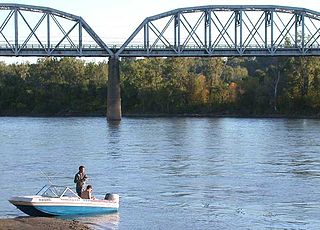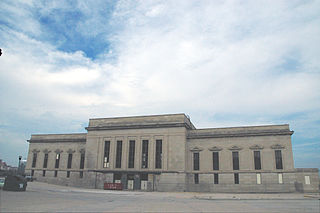
Omaha is the most populous city in the U.S. state of Nebraska and the county seat of Douglas County. It is located in the Midwestern United States along the Missouri River, about 10 mi (15 km) north of the mouth of the Platte River. The nation's 40th-most populous city, Omaha had a population of 486,051 as of the 2020 census. It is the anchor of the eight-county Omaha–Council Bluffs metropolitan area, which extends into Iowa and is the 58th-largest metro area in the United States, with a population of 967,604. Furthermore, the greater Omaha–Council Bluffs–Fremont combined statistical area had 1,004,771 residents in 2020. Omaha is ranked as a global city by the Globalization and World Cities Research Network, which in 2020 gave it "sufficiency" status.

The EMD DDA40X is a 6,600 hp (4,943 kW) D-D locomotive, built by EMD from 1969 to 1971 exclusively for the Union Pacific Railroad. It is the most powerful diesel-electric locomotive model ever built on a single frame, having two 16-645E3A diesel prime movers. Union Pacific has marked DD40X on the cab exteriors, while EMD literature inconsistently refers to this model as either DD-40X or DDA40X.

Union Pacific 3985 is a four-cylinder simple articulated 4-6-6-4 "Challenger"-type steam locomotive built in July 1943 by the American Locomotive Company (ALCO) of Schenectady, New York, for the Union Pacific Railroad. No. 3985 is one of only two Challengers still in existence and the only one to have operated in excursion service.

The Omaha Zoo Railroad (OZRR) is the name of a 2 ft 6 in narrow-gauge heritage railroad located in the Henry Doorly Zoo & Aquarium in Omaha, Nebraska. The railroad offers a narrow gauge excursion train for zoo visitors hauled by a steam locomotive. The train loads passengers at two stations within the zoo. Annual ridership of the Omaha Zoo Railroad is over 200,000 people.

The Union Pacific Missouri River Bridge is a rail truss bridge across the Missouri River between Council Bluffs, Iowa, and Omaha, Nebraska.

The culture of Omaha, Nebraska, has been partially defined by music and college sports, and by local cuisine and community theatre. The city has a long history of improving and expanding on its cultural offerings. In the 1920s, the Omaha Bee newspaper wrote, "The cultural future of Omaha seems as certain of greatness as the commercial future... The symphony orchestra, the Art institute, the Community Playhouse and other organizations are on firm foundations and Omaha is destined to be not only a bigger, but a better city, both financially and culturally." Reviewing Omaha's contemporary arts scene in 2007, the New York Times hailed the city as having "a kind of cultural awakening".
Little Italy is a neighborhood in Omaha, Nebraska which served as the historic home to Omahans of Italian ancestry. It was the source of many laborers for the Union Pacific railroad, much of Omaha's bootlegging during Prohibition and the Santa Lucia Procession, which started in 1924 and continues annually.

Little Bohemia, or Bohemian Town, is a historic neighborhood in Omaha, Nebraska. Starting in the 1880s, Czech immigrants settled in this highly concentrated area, also called "Praha" (Prague) or "Bohemian Town", bounded by South 10th Street on the east, South 16th Street on the west, Pierce Street on the north, and Martha Street on the south, with a commercial area went along South 13th and South 14th Streets, centered on William Street. It was located south of downtown, and directly west of Little Italy. A portion of the neighborhood along South 13th Street was listed on the National Register of Historic Places in 2020.

The Union Stockyards of Omaha, Nebraska, were founded in 1883 in South Omaha by the Union Stock Yards Company of Omaha. A fierce rival of Chicago's Union Stock Yards, the Omaha Union Stockyards were third in the United States for production by 1890. In 1947 they were second to Chicago in the world. Omaha overtook Chicago as the nation's largest livestock market and meat packing industry center in 1955, a title which it held onto until 1971. The 116-year-old institution closed in 1999. The Livestock Exchange Building was listed on the National Register of Historic Places in 1999.

Jobbers Canyon Historic District was a large industrial and warehouse area comprising 24 buildings located in downtown Omaha, Nebraska, US. It was roughly bound by Farnam Street on the north, South Eighth Street on the east, Jackson Street on the south, and South Tenth Street on the west. In 1989, all 24 buildings in Jobbers Canyon were demolished, representing the largest National Register historic district loss to date.
Sheelytown was a historic ethnic neighborhood in South Omaha, Nebraska, USA with populations of Irish, Polish and other first generation immigrants. Located north of the Union Stockyards, it was bounded by Edward Creighton Boulevard on the north, Vinton Street on the south, South 24th Street to the east, and 35th Street to the west. Sheelytown was named for the Sheely Brothers Packing Houses that were located in the area. Sheelytown was annexed by Omaha in 1887. The Omaha Quartermaster Depot was built just east of the community across the Union Pacific tracks.

Transportation in Omaha, Nebraska, includes most major modes, such as pedestrian, bicycle, automobile, bus, train and airplane. While early transportation consisted of ferries, stagecoaches, steamboats, street railroads, and railroads, the city's transportation systems have evolved to include the Interstate Highway System, parklike boulevards and a variety of bicycle and pedestrian trails. The historic head of several important emigrant trails and the First transcontinental railroad, its center as a national transportation hub earned Omaha the nickname "Gate City of the West" as early as the 1860s.
Adams Park is located at 3121 Bedford Avenue in North Omaha, Nebraska. The community surrounding the park recently became the focus of urban planning by the Omaha Chamber of Commerce to promote redevelopment in the area.

Railroads in Omaha, Nebraska, have been integral to the growth and development of the city, the state of Nebraska, the Western United States and the entire United States. The convergence of many railroad forces upon the city was by happenstance and synergy, as none of the Omaha leaders had a comprehensive strategy for bringing railroads to the city.

The Union Pacific Railroad Omaha Shops Facility was a 100-acre (0.40 km2) shop for the trains of the Union Pacific located at North 9th and Webster in Downtown Omaha. With the first locomotives arriving in 1865, it took until the 1950s for the facility to become the major overhaul and maintenance facility for the railroad. This lasted until 1988 when UP moved most of the operations out-of-state. Demolition began soon afterwards.

Lauritzen Gardens are a botanical gardens and arboretum located at 100 Bancroft Street in the South Omaha neighborhood of Omaha, Nebraska. The gardens are open daily during business hours; an admission fee is charged.

City Sprouts is a community garden, urban farm, and educational resource center in the Orchard Hill neighborhood of Omaha, Nebraska. Founded in 1995, City Sprouts is the oldest community garden in the city. The organization is registered as a 501(c)(3) not-for profit entity.

The history of the Union Pacific Railroad stretches from 1862 to the present. For operations of the current railroad, see Union Pacific Railroad; for the holding company that owns the current railroad, see Union Pacific Corporation.
The Union Pacific heritage fleet includes commemorative and historic equipment owned by the Union Pacific Railroad. The fleet currently consists of two historic steam locomotives, three historic diesel locomotives, seventeen modern diesel locomotives in historic or commemorative paint schemes and nearly four dozen passenger cars used on office car specials and excursion trains.

Union Pacific 4023 is a 4-8-8-4 Big Boy steam locomotive preserved at Kenefick Park in South Omaha, Nebraska. Built in 1944 by the American Locomotive Company at its Schenectady Locomotive Works, No. 4023 is one of eight surviving Big Boys and the only one that is part of the class' second group built in 1944, as all seven of the other survivors were part of the first group built in 1941.

















